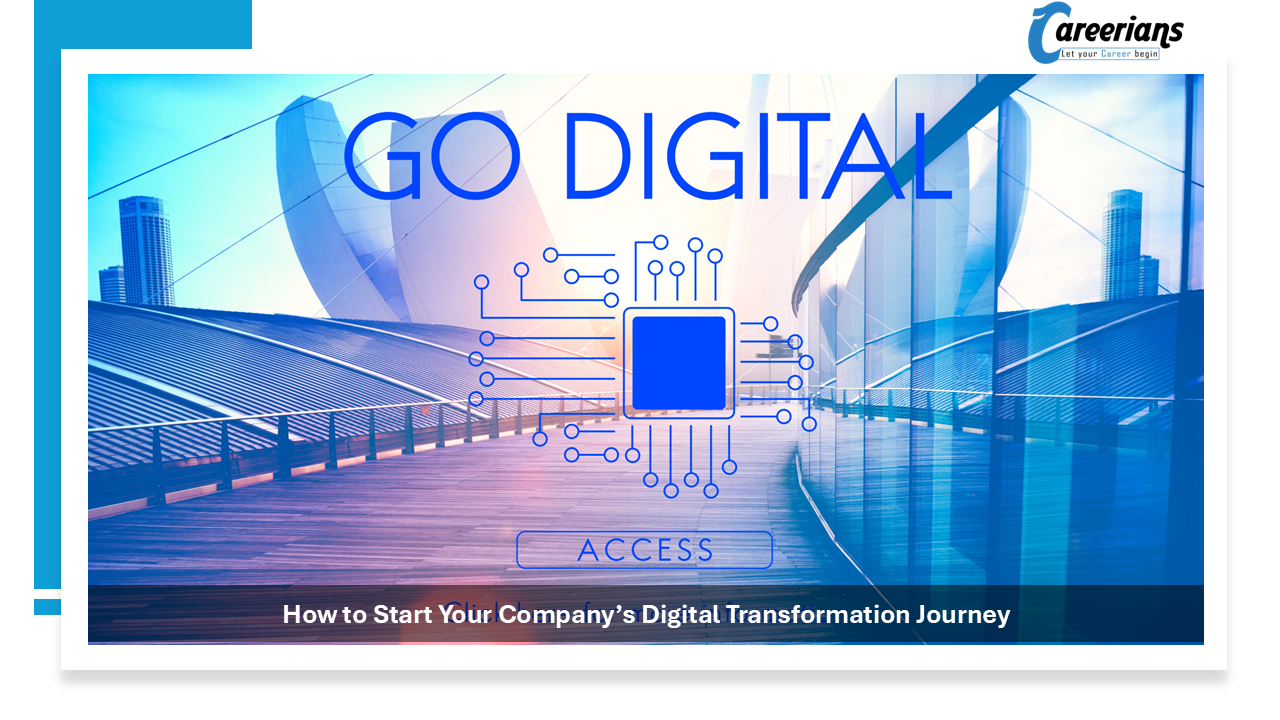
How to Start Your Company’s Digital Transformation Journey
How to Start Your Company’s Digital Transformation Journey
Digital transformation is not just about using new technology or implementing a fancy ERP system.
It’s about changing how your company thinks, decides, and operates.
It’s about transforming culture, leadership mindset, and business processes — not just tools.
But for many business owners and managers in Egypt and the Gulf region, one question always comes first:
“Do we really need to go digital? And if yes, how can we start without wasting money on systems we won’t use?”
The answer is simple: Yes, you do need to start — but you must start the right way.
Digital transformation is not a luxury anymore; it’s a survival strategy.
Companies that adapt will thrive. Those that don’t… will be replaced.
Why Mid-Sized Companies Need Digital Transformation the Most
Large corporations have the money and consultants to implement big digital projects.
Small businesses are flexible enough to use low-cost digital tools quickly.
But mid-sized companies? They’re stuck in the middle — complex operations, limited resources.
That’s why they’re the ones who can benefit the most from smart, cost-effective transformation.
In Egypt, sectors like construction, food manufacturing, logistics, and retail distribution are already feeling pressure.
Competitors that adopted digital tools are becoming faster, cheaper, and more customer-oriented.
In the Gulf, mid-sized companies in maintenance, trading, and education are under similar pressure — digital readiness is no longer optional.
And digital transformation doesn’t mean launching massive IT projects.
It can start small:
-
Automating financial reports instead of using paper
-
Tracking customer orders using a CRM
-
Digitizing attendance or payroll
-
Creating a management dashboard for decision-making
Every transformation starts with one smart, well-chosen step.
Step 1: Start with Management, Not Technology
The biggest mistake managers make is starting from the end — buying systems before defining the problem.
Digital transformation is not about “getting software”; it’s about fixing how your company operates.
Start by asking three key questions:
-
What are the most time-consuming or costly processes in my company?
-
Which decisions are made based on gut feeling rather than data?
-
What complaints do I hear repeatedly from customers or employees?
These answers will reveal your true digital priorities.
For example, if your team wastes hours reconciling invoices or sending emails between departments, automation should start there.
Transformation starts with understanding your business reality — not with technology.
Step 2: Build a Clear Digital Vision
Once you understand your pain points, define your digital vision — what do you want technology to achieve for your company?
Ask yourself:
-
Do I want to increase revenue?
-
Reduce costs?
-
Improve team efficiency?
-
Enhance customer experience?
Each goal leads to a different digital path:
-
For higher sales → CRM, e-commerce, and marketing automation tools.
-
For better efficiency → ERP systems, RPA, and workflow automation.
-
For data-driven decisions → BI dashboards and data analytics.
Your vision should connect business goals to digital actions.
Technology is the vehicle, not the destination.
Step 3: Form a Digital Transformation Team
Digital transformation is not an IT project.
It’s an organizational project that touches every department — HR, finance, operations, marketing, procurement, and customer service.

Form a small core team that includes:
-
A project lead (ideally you, or an operations head)
-
Representatives from key departments
-
One IT member or advisor
-
Optionally, an external consultant for guidance
This team should set priorities, evaluate tools, manage the roadmap, and ensure communication across departments.
The keyword here is collaboration — transformation fails when departments act separately.
Step 4: Assess Your Digital Readiness
Before implementation, you need to know where your company stands today.
You can use a digital maturity assessment or create your own simple evaluation.
| Area | Description | Readiness Level |
|---|---|---|
| Leadership | Does top management actively support transformation? | Low / Medium / High |
| Processes | Are your workflows documented and standardized? | |
| Technology | Do you have the right infrastructure and systems? | |
| Data | Do you rely on accurate data for decisions? | |
| Culture | Are employees open to change and innovation? |
If leadership is ready but culture is weak → focus on training and communication.
>If processes are chaotic → fix documentation before digitalization.
>If technology is outdated → start with lightweight, scalable tools.
Know your starting point before you move.
Step 5: Implement in Phases — Learn, Expand, Integrate
Digital transformation is a marathon, not a sprint.
Break it down into four stages:
1. Pilot Phase
Start with one clear, limited project — something visible and valuable.
Try automating one department or one process.
For example, use Power BI for financial reports or Zoho Projects for tracking operations.
The purpose isn’t perfection; it’s learning by doing.
2. Scaling Phase
If the pilot works, expand gradually to other departments.
Train your staff.
Set clear internal communication about what’s changing and why.
Remember: every department adopts technology differently — finance, HR, and operations have different speeds and fears.
3. Integration Phase
Once multiple tools are in place, connect them.
Link HR systems to payroll, link sales to inventory, link CRM to accounting.
The goal is to create a data-driven ecosystem where all departments share information.
4. Optimization Phase
Digital transformation never ends.
Review your systems regularly:
-
Are costs going down?
-
Is productivity up?
-
Are customers more satisfied?
-
Is your team using the tools willingly?
Real transformation is when continuous improvement becomes a habit.
Step 6: Manage Change, Not Just Technology
Technology doesn’t fail — people do, when they don’t understand the change.
Resistance is the biggest killer of digital projects.
To manage change effectively:
-
Communicate the “why.” Show how digital tools make their jobs easier.
-
Involve them early. Ask for input before implementation.
-
Train effectively. Don’t just show features — teach how it helps their daily work.
-
Celebrate wins. Highlight quick successes to build momentum.
When people feel included, they’ll support the journey, not resist it.
Step 7: Measure What Matters
If you can’t measure it, you can’t manage it.
Create KPIs that show if digital transformation is actually delivering value.

Some practical examples:
-
Time saved per process
-
Reduction in human errors
-
Customer satisfaction ratings
-
Percentage of data-driven decisions
-
System usage rates across departments
Hold quarterly reviews. Adjust the plan if something’s not working.
Remember, measurement keeps the journey grounded in results.
Step 8: Avoid the Common Traps
Here are the five mistakes that destroy most transformation initiatives:
-
Starting with software, not strategy.
Many companies buy tools before defining the problem.
Result? An expensive system no one uses. -
Weak leadership commitment.
If top management isn’t fully onboard, no department will take it seriously. -
Overplanning, under-executing.
Transformation happens by doing, not by endless meetings. -
Ignoring people.
Digital change is 80% about mindset, 20% about systems. -
No sustainability plan.
Without continuous follow-up, everything falls back to old habits.
Step 9: Lessons from Real Cases
From dozens of mid-sized companies in Egypt and the Gulf, here are recurring lessons:
-
Start small, start smart. Choose one area that delivers visible results fast.
-
Select practical partners. Work with vendors who understand your business reality, not just tech jargon.
-
Stay close to your team. Listen to their challenges. Support them.
-
Track ROI from day one. Every digital move should have measurable value.
-
Accept partial failures. Every setback teaches you something valuable.
Transformation is a process of learning, not perfection.
Step 10: Think of Digital as a Culture, Not a Project
True digital transformation isn’t a one-time event — it’s a continuous mindset.
It’s about replacing manual thinking with data-driven logic,
replacing silos with collaboration,
and replacing fear with curiosity.
In Egypt and the Gulf, the next few years will define which companies stay relevant and which fade away.
The winners will be those that see technology not as a cost, but as a multiplier of efficiency and innovation.
You don’t need a million-dollar budget to start.
You just need clarity, consistency, and commitment.
Start where you are. Use what you have. Learn as you go.
Digital transformation isn’t about becoming perfect overnight.
It’s about building a smarter version of your company — step by step.
Careerians Practical Summary
As a business leader, here’s how to start today:
-
Identify one problem that slows your operations.
-
Find one simple digital solution to fix it.
-
Measure the results and expand gradually.
The goal is not to digitize everything instantly —
it’s to create a company that learns, adapts, and grows continuously.
Because in today’s world,
digital transformation is not an option — it’s the new foundation of business success.




